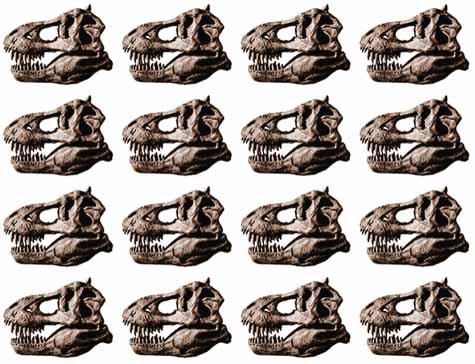 The novels of Patrick McGrath are often described as Gothic. They unfold across foggy landscapes and rolling moors, on marshes dotted with isolated houses and dead trees. There is a lot of rain.
The novels of Patrick McGrath are often described as Gothic. They unfold across foggy landscapes and rolling moors, on marshes dotted with isolated houses and dead trees. There is a lot of rain.
McGrath’s characters are frequently deformed, crippled, mad, or somehow undefined, both psychologically and sexually; they are sinister, if naive, and quietly aggressive, weaving conspiratorial plots around one another with a tightness and an intricacy, and a psychological intensity, till something dreadful occurs – and the book then lurches on to its brutal and unhappy ending.
Amidst tropical swamps and London graveyards, crumbling barns and basements, operating theaters and unused bedrooms, we find incest, murder, and suicide – as well as the creeping, subterranean shadows of mold and rot.
But it is the settings, and not the plots, of Patrick McGrath’s novels that led me to speak with him for BLDGBLOG.
For those brackish marshes and dust-filled hospital wards are extraordinarily well-described; indeed, McGrath’s eye is intimidating in its attention to detail, supplying information across the senses, giving readers the taste, smell, and sound of his fictional worlds, in beautifully crafted sentences.
His landscapes are precise, vivid, and worth re-reading.
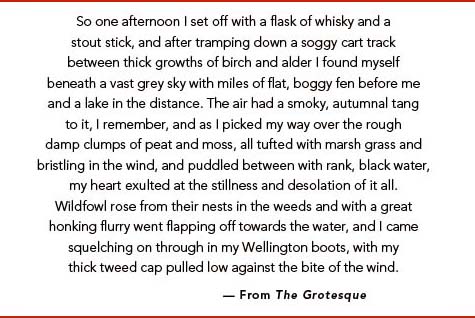 A question often asked on this website is: what do novelists, artists, and filmmakers want from landscape and the built environment? More specifically, how can architecture assist a writer as he or she constructs a novel’s storyline? Are certain types of buildings more conducive to one kind of plot than to another?
A question often asked on this website is: what do novelists, artists, and filmmakers want from landscape and the built environment? More specifically, how can architecture assist a writer as he or she constructs a novel’s storyline? Are certain types of buildings more conducive to one kind of plot than to another?
And what about landscape? How does landscape lend itself to literary effect – and could landscape architects actually learn something about the drama of designed space by turning to a novel instead of to a work of theory?
To the work of Patrick McGrath, for instance?
In the following interview, Patrick McGrath talks to BLDGBLOG about Romanticism, the Sublime, and the origins of Gothic literature, from Mary Shelley’s Alpine wastes to the forests of Bram Stoker, by way of Edgar Allan Poe and the frozen seas of the Antarctic.
We discuss David Lynch, The Sheltering Sky, the architecture of psychiatric institutions – where cell doors always open outward – and the spectacle of unfinished castles soaked with rain on the British moors. We pass through mountains, abbeys, and malarial swamplands, referring to Joseph Conrad, amateur paleontology, and the featureless voids of the Sahara.
We spoke by telephone.
 [Image: Novelist Patrick McGrath].
[Image: Novelist Patrick McGrath].
• • •BLDGBLOG: First, on the most basic level, could you talk about what makes a landscape “Gothic”? Is it the weather, the landforms, the isolation, the plantlife…? Further, in your own work, what is it, on a psychological level, that unites, say, the crooked and leafless trees of the British moors with the coastal swamps of Honduras?
Patrick McGrath: Not an easy question to answer! As you point out, a landscape could be tropical – or it could be Arctic, and it could still have those qualities that we might consider Gothic. It’s hard to know just what these landscapes have in common.
I suppose we have to go back to the origins of Romanticism, and to Edmund Burke‘s book on the Sublime, and look at his notions of the horrid and the terrible. There were landscapes that emotionally aroused the people of that time – but because of their what? Their magnificence in some way. The sheer scope and grandeur of the high mountains – the Alps which Mary Shelley described very powerfully in Frankenstein – or the eastern European landscape in Bram Stoker’s Dracula: the loneliness and the remoteness of those mountains, the density of the forests, the fact that there are very few human beings there. Nature dwarfs humanity in such landscapes. And that will arouse the sense of awe that is made particularly dramatic use of in Romantic and Gothic literature.
Then, at the other end of the scale, we have a tropical landscape such as Conrad’s Congo in Heart of Darkness where it’s almost the reverse: it’s the constrictiveness and the fecundity of nature, the way it presses in on all sides. Everything is decaying. And decay, of course, is a central concept in the Gothic. So when you have tropical vegetation you do have a sense of ooze and rot – of swampiness.
BLDGBLOG: You mentioned that certain landscapes might have been “emotionally arousing” for the people of that era – but this implies that what makes a landscape emotionally arousing will change from generation to generation. If that’s the case, might something altogether different be considered Gothic or Romantic today? Have you noticed a kind of historical shift in the types of landscape that fit into the Gothic canon?
McGrath: My first thought is: not so much of landscape – but let’s say in the view of the city.
My second novel, Spider, was inspired by a book of photos by Bill Brandt. He captured the seedy, ill-lit character of the East End of London of the 1930s in such powerfully human character – illicit liaisons on wet cobbled streets, toothy barmaids in grotty pubs, pulling pints for sardonic men in cloth caps – that I was at once inspired to find a story there. But I do think the Victorian slum – the dark, rather shadowy streets that have a sort of sinister and rather threatening feel to them – could be replaced by the blandness of a suburb.
I’m thinking of what David Lynch did in Blue Velvet, with a scene of apparent utter normality. Think of the opening scene where a man is watering his garden and everything seems, well, perfect in that neat and orderly suburban way and yet his camera then goes beneath the grass and we see all sorts of forms of life that are slimy and grotesque and that aren’t apparent in that hygienic world above.
So there may be something in that: the suburb as the most Gothic of sites. Think of the work, say, of Gregory Crewdson.
BLDGBLOG: That raises the question of what sorts of architecture pop up most frequently in Gothic literature: usually English manor houses, church ruins, forgotten attics and so on. Why are certain types of buildings more conducive to one type of storyline and not others?
McGrath: I think you’d have to say that there are two questions here. There’s the conventional, stereotypical Gothic site which tends to be a lonely house high on a hill, probably Victorian, with turrets and the possibility of secret passageways and cellars and attics – places of obscurity, places where the past somehow resides. You know, houses of secrets.
These sites, in turn, would have grown out of the more traditional Gothic architectures – basically the ruins of monasteries and abbeys and convents and such, which dotted the British landscape in the 18th century, after the Reformation. Those first aroused the taste for ruins, and that was the origin of the Gothic. That would be basically a medieval architecture – in ruins, as I say, because of what Henry VIII did to the English church in the 16th century. So those were the places where people like Horace Walpole set their fiction, because the buildings were in such a state of decrepitude.
I think anything that sort of relates to these large, broken down, dilapidated structures would arouse the Gothic effect.
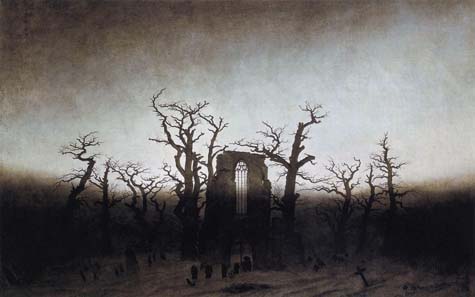
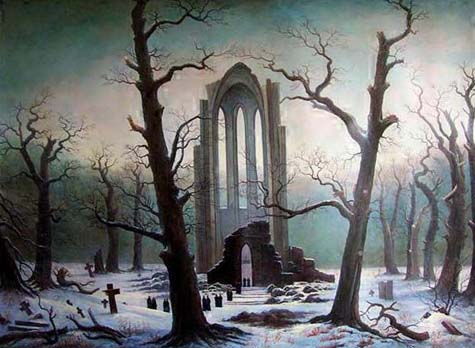 [Images: The Abbey in the Oakwood, 1809-10, and Cloister Cemetery in the Snow, 1817-19, by Caspar David Friedrich].
[Images: The Abbey in the Oakwood, 1809-10, and Cloister Cemetery in the Snow, 1817-19, by Caspar David Friedrich].
BLDGBLOG: Interestingly, though, in the work of J.G. Ballard, you get the same sort of psychological atmosphere – of perversion, violence, and dread – from a totally different kind of built environment: instead of crumbling manor houses, you have corporate office parks in the south of France, or even British shopping malls.
McGrath: Absolutely – and that was going to be the second part of my answer. There is the old Gothic, which does have a very definite architectural style that comes out of the structures of the Middle Ages, as these became ruins and gave off a sense of ghostliness and evil and menace. But then there is what you might call, I don’t know, a new Gothic, where the particular trappings of the old Gothic, the particular stylistic characteristics, are not necessary to produce the same sorts of effects – the feelings of dread, constriction, obscurity, transgression. You can get those from inner city projects, for example, or even a little neat rowhouse.
There was an early Ian McEwan novel, The Cement Garden, where all sorts of perverse wickedness was going on but in a very sort of unmemorable little house, in a street of very similar houses, none of which would particularly smack of evil. Although I did notice, when I was re-reading it, that he uses a little crenellation detail in the architecture of one of these absolutely anonymous little houses. He’s just touching-in this faint hint of the Gothic – as though to say: this is a child of something out of Ann Radcliffe, some decaying monastery in which an aristocrat pursues a maiden in the depths of the night.
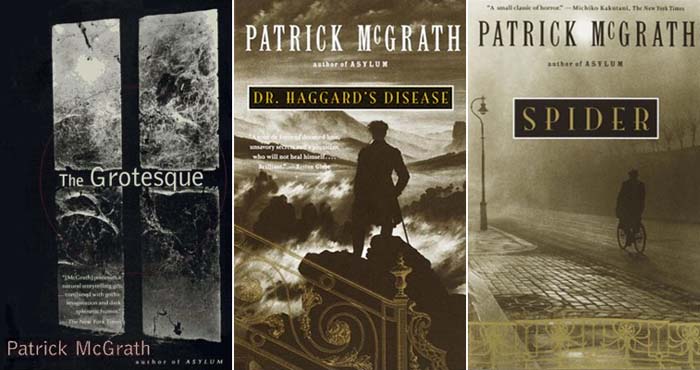 BLDGBLOG: I’m curious if there are any real buildings that you have in mind when you’re describing places like Drogo Hall or Crook Manor. Put another way, could someone ever do a kind of Patrick McGrathian architectural tour, or heritage walk, visiting sites that have inspired your fiction? Where would that tour take them?
BLDGBLOG: I’m curious if there are any real buildings that you have in mind when you’re describing places like Drogo Hall or Crook Manor. Put another way, could someone ever do a kind of Patrick McGrathian architectural tour, or heritage walk, visiting sites that have inspired your fiction? Where would that tour take them?
McGrath: [laughs] Good question. I don’t quite know where I get them from. In part from the imagination, in part from books, books I’ve got around the place with photographs or paintings of buildings, some of which I’ve observed and remembered.
There’s a house called Crook in my first novel, The Grotesque. I found a lovely little book in a second-hand bookstore in New York, called The Manor Houses of England, and I simply leafed through it, picking up details here and there – not only architectural details, but verbal details. The way that aspects of architecture are described – the sorts of terms that are used – can be as much a part of the creation of a building in fiction as a clear, purely visual picture in your mind. You catch a nice phrase that’s used to describe, I don’t know, a Jacobean staircase or a particular piece of detailing or masonry – and you fling it in because it sounds good, rather than just because it evokes a particular image.
But I don’t think there’s a pattern. They’re usually curious amalgams that I put together in my imagination.
BLDGBLOG: I noticed one day that there is a real Castle Drogo. Architecturally, how much of that was an influence on your descriptions of Drogo Hall? Or did you just use the name?
McGrath: It was basically just the name. Castle Drogo’s somewhere down in the West Country, I can’t remember where – I think it looks over Dartmoor. It was built in, I think, the early twentieth century by some rich industrialist, as I remember, who wanted to have a main building with two wings. But then his son was killed in WWI, and he’d only built one wing of the castle. He grew so despondent that he never built the second wing. All the life had gone out of him. So it’s an incomplete structure. It was also essentially an ersatz thing – it wasn’t a proper castle. It was an Edwardian idea of a castle – of which there are many in Britain, of course. But it was the name; the name was very powerful: Drogo.
So I pinched the name and gave it to a building that I largely invented out on the Lambeth Marshes. And, again, the Lambeth Marshes as I describe them don’t really have any resemblance to the Lambeth Marshes as they existed in the 18th century. I mean, I sort of put a Dartmoor on the south of the Thames – and I don’t think it was like that! [laughter]
BLDGBLOG: Well, it works, so…
McGrath: It works – and that’s all you want.
 [Images: Castle Drogo].
[Images: Castle Drogo].
BLDGBLOG: Have you read The Emigrants by W.G. Sebald? One of the stories is partially set in an old, sprawling psychiatric hospital in the forests of New York state. Near Syracuse, I think, or maybe Ithaca. The narrator explains that his uncle once committed himself there voluntarily to undergo electroshock therapy, basically as a way to erase painful memories from some time spent in the Sahara south of Cairo.
McGrath: Now, this is very, very interesting – I’ve read Sebald, but not that particular book. In fact, I’ve just finished a novel which is set in Manhattan and the last couple of chapters are set in a mental hospital in northern New York state. And I had no idea about Sebald using that location – and I didn’t really know about the Victorian institutions you described.
What I did was I took an institution from northern Ontario where I worked when I first came over to North America, and it was very unlike a Victorian institution. It was sort of like a blockhouse – like a penitentiary. And so what I’ve done is I’ve sort of plonked that down in upstate New York – but I might have to rethink how I’ve done that based on what you’ve just said. But this is great to know – I’ve still got time to tear that chapter apart.
BLDGBLOG: Well, some of those hospitals – these big, Gothic complexes – have actually been demolished. But in other cases, they’ve been transformed into apartments and condominiums –
McGrath: Yes, that’s happening in England, too. I visited old Victorian asylums there that have outlived their usefulness and are now being converted into apartments.
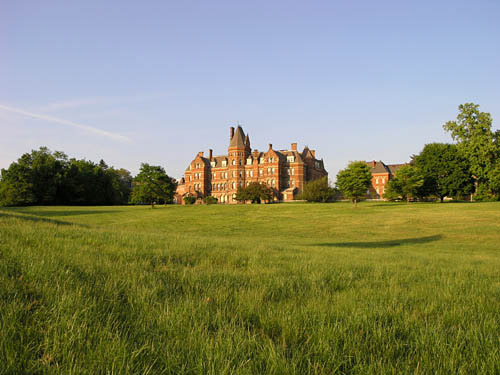 [Image: The Hudson River State Hospital, beautifully photographed by Kirkbridebuildings.com. The rest of that site – especially the other hospitals – is well worth checking out].
[Image: The Hudson River State Hospital, beautifully photographed by Kirkbridebuildings.com. The rest of that site – especially the other hospitals – is well worth checking out].
BLDGBLOG: Returning to the question of landscape, the natural environments in your work are extraordinarily well-described; in fact, there are parts of Asylum that strike me as literal exemplars of superb landscape description. I’d love to know more about how you work: if you actually visit specific locations, driving up to the moors or through the hills of New England, to capture your descriptions on the spot; or if you work from memory, or from imagination, or even from other books of photographs.
McGrath: There have been times when I’ve gone to a place. When I went down to Belize, for instance, and saw what Belize City looks like – the shacks lurching unsteadily over the river, the mangrove swamps and so forth – that just told me, instantly, that here I had the setting of a novel. I took a lot of photos and then basically used what I’d seen. Other times, I just sort of invent it.
I remember when I was writing The Grotesque, I had the Berkshire marshes in there, and I’d been out of England for many years at that point and somebody pointed out to me that, in fact, there are no marshes in Berkshire –
BLDGBLOG: [laughs]
McGrath: – but by then it was too late. I needed there to be marshes and I wanted it to be Berkshire, for some reason, and so there it was: a completely nonexistent landscape had sprung to life.
I don’t know, I look at things and a lot of it comes from reading. I discover details that, for example, in prisons and asylums you will always have the doors opening outwards so that whoever is incarcerated behind that door won’t be able to blockade themselves inside the room. Little details like that give the character of an institution and can be very evocative on the page.
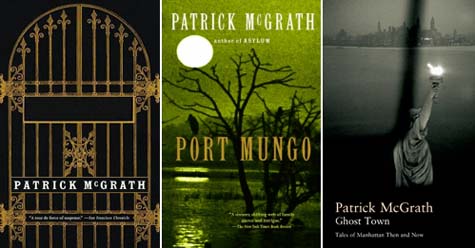 BLDGBLOG: I’m also curious about weather and climate. For instance, a wet climate – with thunderstorms, humidity, and damp – seems to play a major, arguably indispensable, role in the Gothic imagination. Your own novels illustrate this point quite well: from rain-soaked country homes to the Lambeth marshes, from coastal fishing towns to Central American swamps. But can aridity ever be Gothic? In other words, if the constant presence of moisture contributes to a malarial atmosphere of decay, mold, infestation, and disease, might there be a whole other world of psychological implications in a climate where things don’t decay – where there is no mold, where bodies turn to leather and everything can be preserved? Is indefinite preservation perhaps a Gothic horror of its own?
BLDGBLOG: I’m also curious about weather and climate. For instance, a wet climate – with thunderstorms, humidity, and damp – seems to play a major, arguably indispensable, role in the Gothic imagination. Your own novels illustrate this point quite well: from rain-soaked country homes to the Lambeth marshes, from coastal fishing towns to Central American swamps. But can aridity ever be Gothic? In other words, if the constant presence of moisture contributes to a malarial atmosphere of decay, mold, infestation, and disease, might there be a whole other world of psychological implications in a climate where things don’t decay – where there is no mold, where bodies turn to leather and everything can be preserved? Is indefinite preservation perhaps a Gothic horror of its own?
McGrath: Aridity does interest me. It’s an unusual application of the Gothic mood. You usually think of northern European or north American climates and landscapes, but that’s merely because, traditionally, that’s where these sorts of stories have been set. But I can very well imagine aridity being a place, or a site, for such a story.
I think you could safely say that one of the themes of the Gothic is the sins of the father being visited upon the sons – in other words, there is no escaping the past. The past will always haunt the present. And this is certainly true of Gothic stories that are set in crumbling old houses: there’s always some piece of evil that has occurred in a previous generation that will work itself out on the current generation. So that continuation – or persistence – of the past is what you’re expressing: it’s the skeleton that can’t be disposed of.
But I’m trying to think if I know of a Gothic tale set in a desert, and the only thing I can come up with is… I think it’s an old Erich von Stroheim movie. It might be called Greed? There’s a man who has, somehow or another, wound up handcuffed to his companion – and the companion has died. This is in the quest for gold. Somehow or another their greed has got them into an impossible situation: they’re handcuffed, the companion has died, and so we have a man crawling across the desert handcuffed to a corpse. It being a desert, of course, he’s doomed. But that’s a very powerful image of an utterly arid landscape.
In the spirit of a new Gothic, one that isn’t dependent on very particular types of landscape or architecture, you could certainly exploit an arid landscape in order to create a condition of extreme thirst, extreme solitude, extreme desperation – all of which would be appropriate states of mind for a Gothic story. I just can’t think of many examples.
BLDGBLOG: It never really occurred to me to refer to this book as “Gothic” before, but there’s The Sheltering Sky by Paul Bowles – where you see people completely destroyed by the desert. The Sahara is presented as this strangely dark landscape, something that they can’t comprehend culturally and they can’t survive physically.
McGrath: Whether you could get away with calling that Gothic, I don’t know! But, certainly, there is horror in that environment. It does have that in common with the Gothic. You can’t have the Gothic without horror, and the desert is a place where, you’d think, horror is always close at hand.
BLDGBLOG: Meanwhile, some of the earliest Gothic fiction was actually polar – Mary Shelley’s Arctic chase in Frankenstein is an obvious example. I’m curious if glacial landscapes and frozen seas attract you? Might there someday be a kind of Arctic Port Mungo?
McGrath: Well, again, in the novel that I’ve just finished, I wanted to take my character, when he’s pretty much spiraled down as far as he can get in New York City, to a place of snow. And there are all sorts of precedents for this. Frankenstein, as you say, begins up in the Arctic Sea – and ends there. I think the final image is Frankenstein pursuing his creature across the frozen waste – a vast white landscape. There’s also Poe’s The Narrative of Arthur Gordon Pym, which comes to a place of great whiteness; and, almost contemporary with that, is Melville’s white whale.
There is something about whiteness that is almost identical to blackness in terms of what it can evoke. I think it must be about featurelessness: the horror that comes of there being nothing there. It’s a white nothing instead of a black nothing.
But the absence of color would suggest a kind of emptiness, a draining of life and meaning. A void. And the Gothic is very fond of a void. And Melville was certainly onto that. I mean, you can’t help but see that the white whale is really just a blank screen onto which Ahab has projected all sorts of powerful and twisted emotions – but, in itself, it is merely a screen. Melville’s possibly suggesting that all of nature is just such a blank screen, and that it is the business of humans to project meaning onto nature, that meaning is not inherent, is an idea that I think we can comfortably live with now; but, I think, in the 19th century, it was probably a great deal more threatening to God-fearing people.
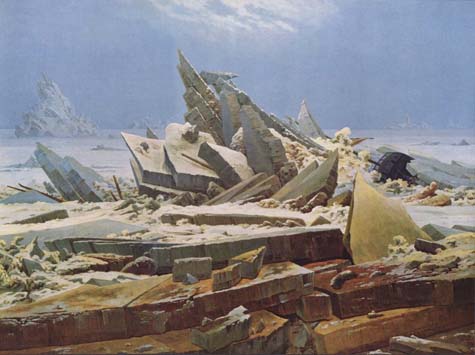 [Image: The Sea of Ice, 1824, by Caspar David Friedrich].
[Image: The Sea of Ice, 1824, by Caspar David Friedrich].
BLDGBLOG: One of the most striking images I’ve read in years is actually your character Hugo Coal, from The Grotesque, assembling his dinosaur skeleton in the family barn. I’d love to hear your thoughts about what went into that image – but also what you think about the human encounter with prehistoric monstrosity: with dinosaur bones, and marine fossils, and the utter strangeness of the earth’s inhuman past.
McGrath: What interested me – before I’d even thought through aspects of deep time, and what that means – was that a man could go to Africa and collect a bunch of bones and crate them up and bring them back, and then spend the rest of his life trying to see what fitted where. This may be completely implausible, in terms of paleontology, but I just liked the notion of Sir Hugo sitting there in his barn, year in, year out, trying to make a pattern, to make a structure – and continuing to get it wrong. It seemed, somehow, very much in the spirit of human endeavors to discover the truth, or to figure out how nature works – or even, within that book, to get an answer to the mystery of who killed Sidney. It was to do with the fallibility of knowledge that was contained within this enterprise of getting the bones to fit – and they won’t! [laughs] There’s always a bit left over, or something that won’t go where it’s supposed to go. So that was the aspect, the epistemological aspect, of reconstructing a skeleton that first fascinated me.
Then there was the notion of this thing coming from deep in the past and being now extinct – from so deep in the past that it no longer had any place on this earth – and the suggestion that Sir Hugo, in a sense, was the same. He, too, was a dinosaur; his day, as a representative of a certain social class, was past.
But the first impulse that I had was that this was a carnivorous creature. This wasn’t a gentle herbivore Hugo’s got there. This was a creature of enormous violence and absolute rapacity, capable of tearing its prey to pieces, and I wanted to suggest that those sorts of implicit violent energies were now swirling about this old country house.
BLDGBLOG: In some ways, though, it seems like the contemplation of the earth’s biological past lends itself well to the Gothic mood – but contemplating, say, the earth’s geological past just doesn’t have the same psychological impact. For some reason, rocks just aren’t very Gothic.
McGrath: Well, I remember the way that Conrad handles the river in Heart of Darkness: he speaks of the journey that Marlow takes to get to Kurtz as being a journey through, or deeper into, the geological history of Africa. I forget how he does it, but he gives you the sense that, as the boat moves up the river, it is also descending through eons of time. So there is almost a sense of a geological regression occurring as Marlow moves toward a man who has committed an act of enormous moral regression. Everything is about a movement downwards in that book. I’d say that he employs geological descent to mirror a moral descent.
BLDGBLOG: Of course, there’s also Hugo Coal’s surname: coal, a geological product.
McGrath: There you are. Absolutely. That was no accident. Again, I’m referring to deep layers of what once had been wood, and that now, through the operation of time and pressure, is something quite different.
BLDGBLOG: Finally, I’d like to ask you about islands. You’re from England, with a home in Manhattan, and you’ve lived on “a remote island in the north Pacific.” Interestingly, though, your work doesn’t include a lot of islands – indeed, there are very few scenes at sea. Do the Gothic possibilities of islands, or archipelagos, have any literary interest for you?
McGrath: Well, that’s true. I don’t know why that should be. I’ve put people by the water often enough – a lot of my people seem to stand in high places gazing out to sea – but the notion of an island as a… I suppose the island gives you the possibility of a closed community – and that’s always a good site to play out a story in. You can just say that the world doesn’t extend beyond the borders I’ve imposed upon it. I suppose the use of a village is a sort of island. The last book I’ve done is set in Manhattan almost exclusively, but… I’ve never sort of literally done an island.
I think every novelist – unless you’re Dickens, maybe, where you just want to give a great sweep of an entire society – finds a way of creating islands, or social islands, anyway. The family is a sort of island. A prison, an asylum, is a sort of island. A town can be a sort of island. I mean, every novel has to limit its scope geographically and socially, so I suppose we create islands – but I’ve never particularly been drawn to an island itself. Though I do have a novel somewhere in the back of my head set on an island in the Mediterranean.
I suppose the answer is: I don’t see the need for an island in itself, when the only point to an island would seem to be to draw a circle around a community. Unless it was the notion of being cut-off… That would be a good reason to make an island. You know, where the weather closes in and your people have no way of escape. I can see that being a way you might want to use an island. But I just haven’t felt the need yet.
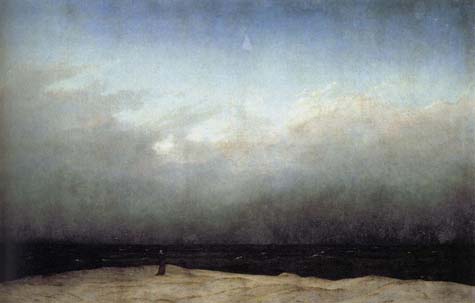 [Image: Monk by the Sea, 1809, by Caspar David Friedrich].
[Image: Monk by the Sea, 1809, by Caspar David Friedrich].
BLDGBLOG: As I mentioned, your bio refers to a “remote island in the north Pacific.” I’m just wondering where exactly that was?
McGrath: There’s a group of islands called the Queen Charlottes. They’re off the northwest coast of British Columbia. If you were to find Prince Rupert on the map, you would then just go due west about 80 miles, and they’re just south of the Alaskan panhandle. There are two main islands: Moresby and Graham. Moresby is uninhabited and Graham has, oh, two or three little towns. That’s where I lived a few years.
I was a schoolteacher back in those days, and I’d been living in Vancouver, and I wanted to get out of the city, basically. So I got a job teaching there, and, while I was there, I basically gave up teaching and built a cabin and declared myself a writer.
That was the beginning.
• • •BLDGBLOG would like to thank Patrick McGrath for taking the time to have this conversation – which he and I both hope to continue in a few months’ time: so watch out for another interview with Patrick McGrath here on BLDGBLOG, to be posted, I hope, this winter.
Meanwhile,
Asylum,
The Grotesque, and
Spider are all great places to start, if you’re looking for an introduction to Patrick McGrath’s work.
Spider, of course, was recently filmed by
David Cronenberg. A new novel, meanwhile, called
Trauma, is due out in April 2008.
Finally, this
PDF contains a much longer, and older, interview with McGrath (in which he describes the
grotesque as “things beginning to merge, things becoming undifferentiated” – the grotesque is a “breakdown, in every dimension that I could imagine, in the organic, in the social, in the sexual, in the natural”). Briefly, then, it’s interesting to point out that one of the manifestos mentioned in
the previous post discusses the grotesque in terms of monstrosity, beauty, and architecture.
 [Image: From The Hunt For Red October, via Quora].
[Image: From The Hunt For Red October, via Quora]. [Image: From
[Image: From  [Image: The beginning of the Broomway path, at
[Image: The beginning of the Broomway path, at  [Image: One possible end-point—not the furthest—of the “Doomway” path].
[Image: One possible end-point—not the furthest—of the “Doomway” path]. [Image: The endpoint of the Broomway tidal path].
[Image: The endpoint of the Broomway tidal path].


 [Image: Inside Tadao Ando’s studio in Osaka; photo by Kaita Takemura, via
[Image: Inside Tadao Ando’s studio in Osaka; photo by Kaita Takemura, via 





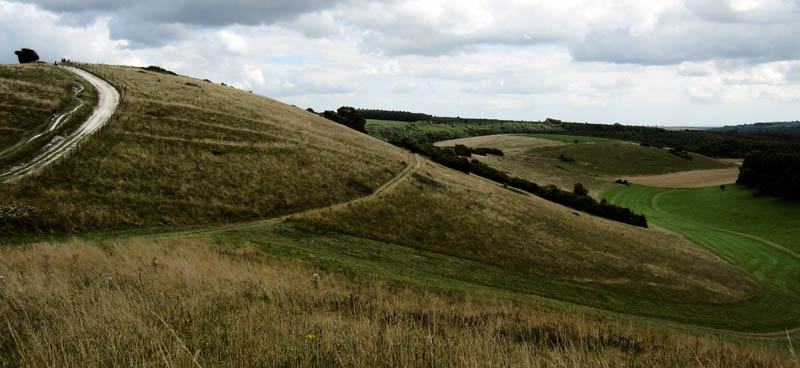 [Image: An unrelated photo by BLDGBLOG].
[Image: An unrelated photo by BLDGBLOG].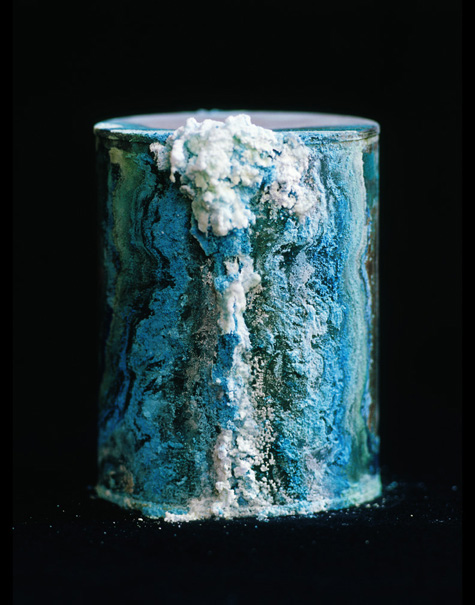 [Image: From
[Image: From 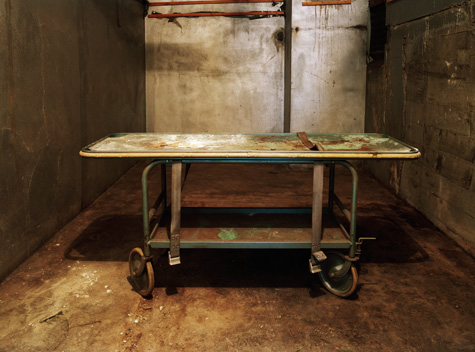
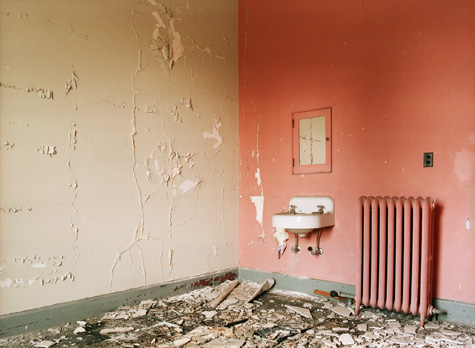
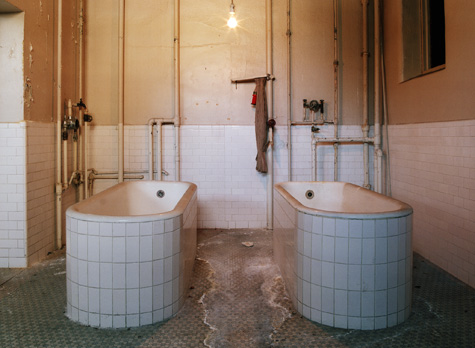 [Image: Abandoned rooms of the hospital. From
[Image: Abandoned rooms of the hospital. From 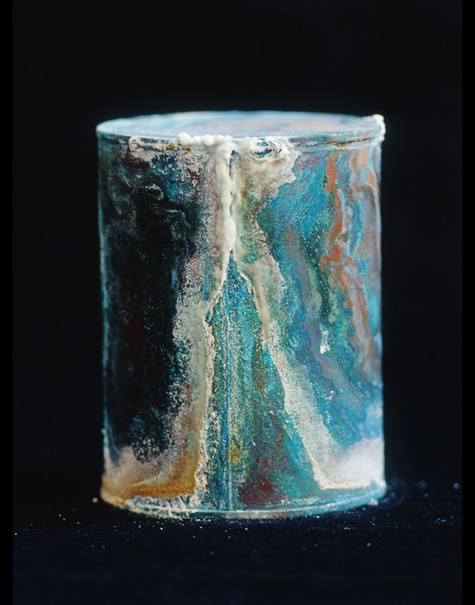 [Image: From
[Image: From 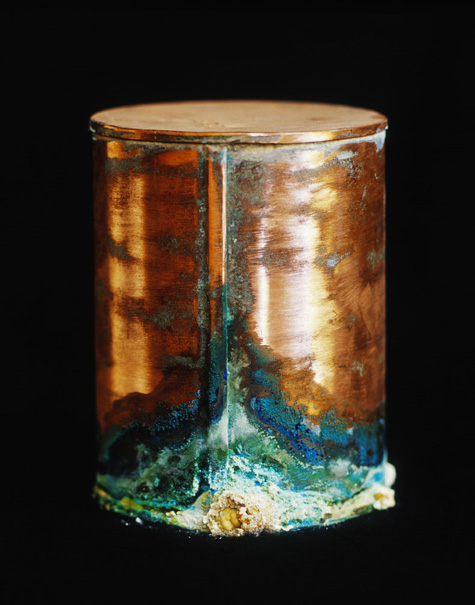
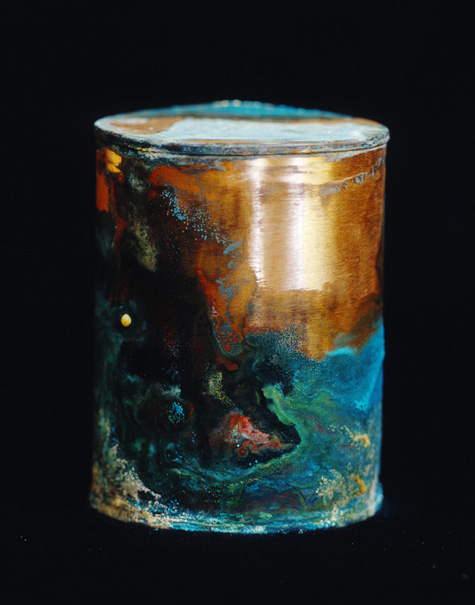

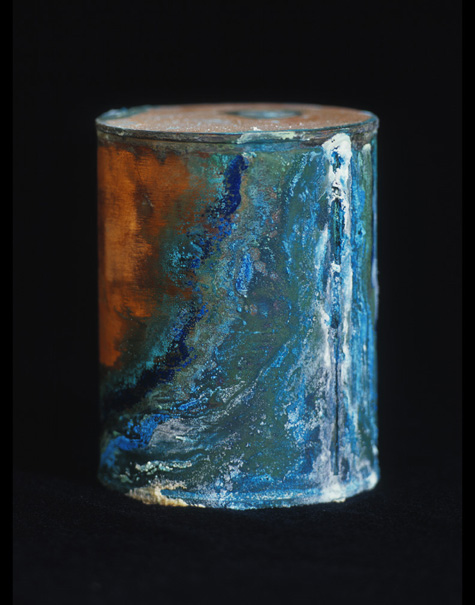 [Image: From
[Image: From 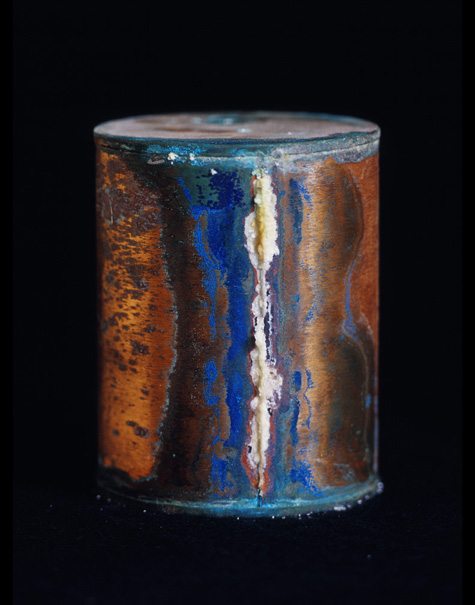 [Image: From
[Image: From 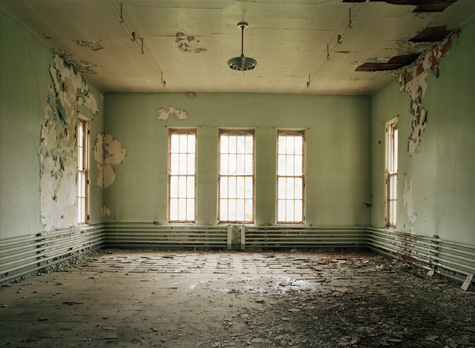 [Image: From
[Image: From 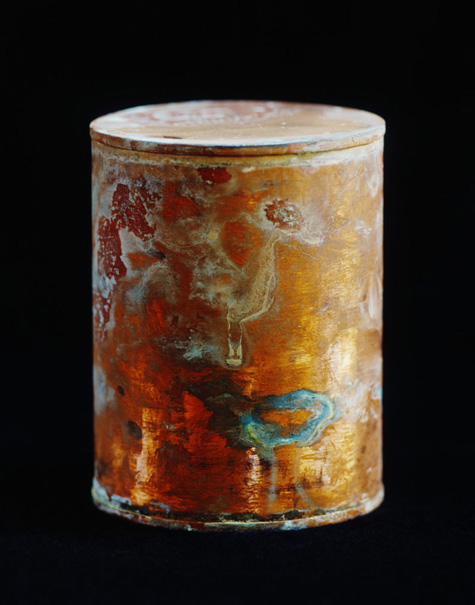 [Image: From
[Image: From  [Image: From
[Image: From  The novels of
The novels of  A question
A question  [Image: Novelist Patrick McGrath].
[Image: Novelist Patrick McGrath].
 [Images: The Abbey in the Oakwood, 1809-10, and Cloister Cemetery in the Snow, 1817-19, by
[Images: The Abbey in the Oakwood, 1809-10, and Cloister Cemetery in the Snow, 1817-19, by  BLDGBLOG: I’m curious if there are any real buildings that you have in mind when you’re describing places like Drogo Hall or Crook Manor. Put another way, could someone ever do a kind of Patrick McGrathian architectural tour, or heritage walk, visiting sites that have inspired your fiction? Where would that tour take them?
BLDGBLOG: I’m curious if there are any real buildings that you have in mind when you’re describing places like Drogo Hall or Crook Manor. Put another way, could someone ever do a kind of Patrick McGrathian architectural tour, or heritage walk, visiting sites that have inspired your fiction? Where would that tour take them? [Images:
[Images:  [Image: The
[Image: The  BLDGBLOG: I’m also curious about weather and climate. For instance, a wet climate – with thunderstorms, humidity, and damp – seems to play a major, arguably indispensable, role in the Gothic imagination. Your own novels illustrate this point quite well: from rain-soaked country homes to the Lambeth marshes, from coastal fishing towns to Central American swamps. But can aridity ever be Gothic? In other words, if the constant presence of moisture contributes to a malarial atmosphere of decay, mold, infestation, and disease, might there be a whole other world of psychological implications in a climate where things don’t decay – where there is no mold, where bodies turn to leather and everything can be preserved? Is indefinite preservation perhaps a Gothic horror of its own?
BLDGBLOG: I’m also curious about weather and climate. For instance, a wet climate – with thunderstorms, humidity, and damp – seems to play a major, arguably indispensable, role in the Gothic imagination. Your own novels illustrate this point quite well: from rain-soaked country homes to the Lambeth marshes, from coastal fishing towns to Central American swamps. But can aridity ever be Gothic? In other words, if the constant presence of moisture contributes to a malarial atmosphere of decay, mold, infestation, and disease, might there be a whole other world of psychological implications in a climate where things don’t decay – where there is no mold, where bodies turn to leather and everything can be preserved? Is indefinite preservation perhaps a Gothic horror of its own? [Image: The Sea of Ice, 1824, by
[Image: The Sea of Ice, 1824, by  [Image: Monk by the Sea, 1809, by
[Image: Monk by the Sea, 1809, by